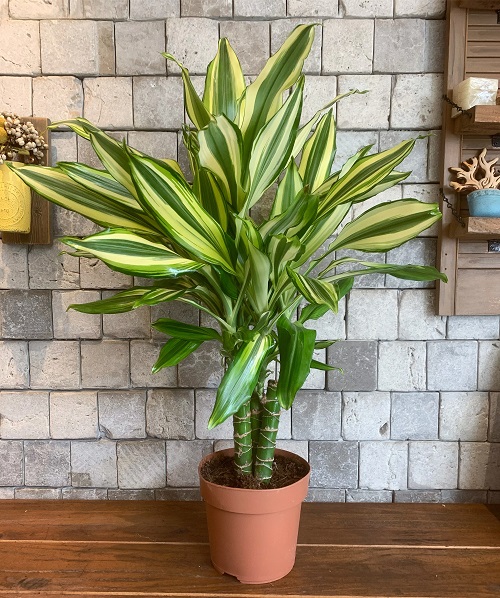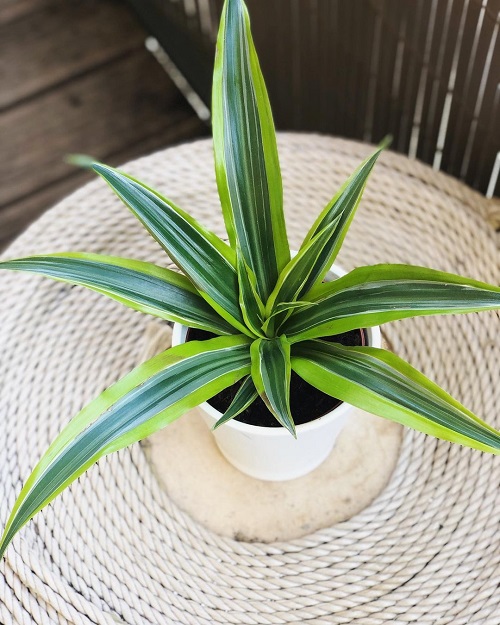If you’re looking to add some tropical charm to your home, Mass Cane Plant is a perfect choice. Here’s a complete guide to help you!

Mass Cane Plant, also known as Dracaena Fragrans, is a popular indoor plant known for its tall, slender stems and lush green leaves. Here’s everything you need to know about growing this beautiful houseplant!
- Botanical Name: Dracaena Fragrans
- Grows to a height of 4-6 feet
- Flaunts beautiful, striped variegation of light green and creamy yellow foliage
- Features a thick, woody stem, giving it a tree-like appearance
- Toxic to dogs and cats
Learn about Growing Red Bristle Philodendron Indoors here
Mass Cane Plant Profile
The Mass Cane Plant, also known as the Dracaena Fragrans, is a stunning indoor plant that brings a touch of the tropics to your home. With its tall, slender stems crowned with lush, variegated green-yellow leaves, this plant has a sophisticated, elegant look that will elevate any room.
If you are looking to include a specimen to fulfill your desire of growing an indoor tree-like houseplant without the hassle of high-maintenance, the Mass Cane Plant is your best buddy!
Propagating Growing Mass Cane Plant

The Mass Cane Plant can be easily propagated by division. Simply unpot the plant from its container and detangle the rootball manually. Gently divide the root crumb into smaller sections, using a sterile knife, ensuring each section has a few healthy leaves. Plant each section into individual pots of well-draining growing medium.
Keep the medium evenly moist and place the pots as a location with bright, indirect sunlight. You’ll notice new growth within 2-3 weeks.
Requirements for Growing Mass Cane Plant

Light
Mass Cane Plant thrives in bright, indirect light but can tolerate low light levels. It’s best to place the plant near a window with filtered light, if you don’t want the leaves to lose ita variegation and go dull.
A well-lit bookshelf or center table by your northern or eastern windows can be the plant’s happy place.
Soil
Just like humans, the Mass Cane Plant needs enough room to breathe and grows best in well-draining, fertile medium. A soilless potting mix, comprising of peat moss, perlite, and sand will provide the right combination of moisture retention and good drainage. Avoid using heavy, clay soils that hold too much moisture, and will apparently lead to root rot.
Water
Mass Cane Plant likes to be kept evenly moist but not waterlogged. Water the plant when the top inch of soil feels dry to touch. However, do not let the medium dry out completely as it will turn the foliage dull and lose their shine.
Follow a weekly deep watering session to hit the perfect moisture balance in the medium.
Temperature & Humidity
Mass Cane Plants thrive in warm environments with temperatures ranging from 60°F to 75°F. They are not tolerant to extreme cold or hot temperatures, so it’s essential to keep them away from temperature fluctuations to ensure their growth and survival.
The plant require high humidity levels, with an ideal range of 60-70%, a lack of which can cause the leaves to brown and become brittle. To maintain adequate humidity levels, mist the leaves regularly or place a humidifier nearby.
Mass Cane Plant Care
Fertilizers
This handsome houseplant require regular fertilization to support their growth and maintain their vibrant green leaves. An NPK blend of 5-10-5 should be applied every 4-6 weeks during the growing season, after diluting it to half its strength.
Overfertilization with high fluoride and boron levels can cause root damage and yellowing of the leaves, so better you keep your plant off such practices.
Pests and Diseases
Mass cane plants are prone to various pest diseases, including spider mites, mealybugs, and scales. Regularly inspecting the plant for any signs of infestation and using organic neem oil solution or fungicides can help control these pests and prevent any damage to the plant.
Additionally, maintaining proper hygiene and avoiding overwatering can also help prevent pest and disease issues.






